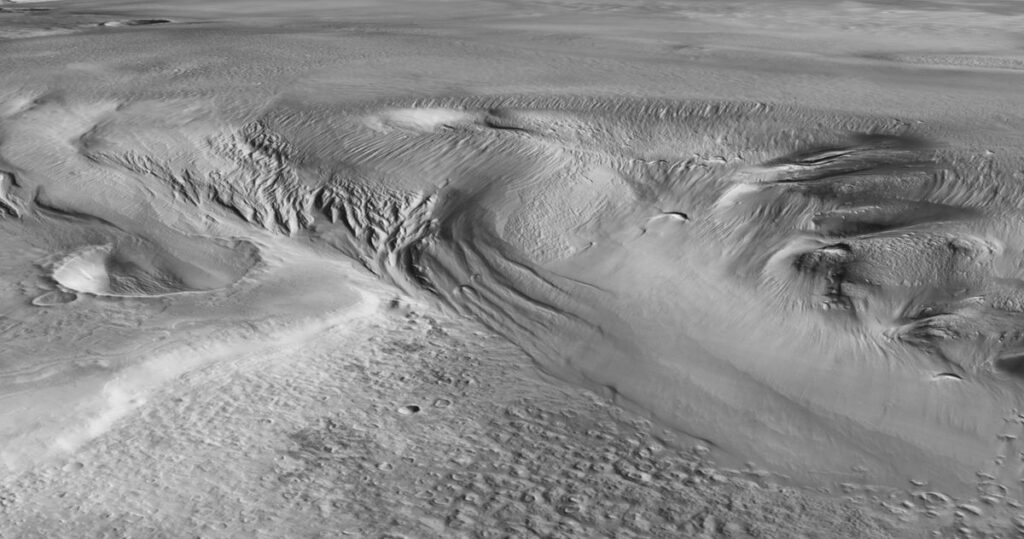Extensive Water Ice Found on Mars Close to the Equator.
The Italian-European Space Agency probe has revealed a major finding in the planet Mars Equator. Under the surface of the outer planets is an ocean of icy dust that is several meters in width. 9 and 8. 9 feet (1. 5 and 2. 7 meters) deep. It can support Mars if it is distributed to the entire surface of Mars. The main probe for this is the Mars Express mission that has been conducting detailed research on the Red Planet for the past two decades under ESA. Previous equatorial ice existence has also been recorded but the latest one recorded is the largest amount of water ice in the equator. Also, it corresponds to researches earlier published about the existence of frozen water on Mars. Thomas Watters, the leader of the Smithsonian Institution team from the US, said he was pleased with the results, since the radar reflectivity matched the signal from the layered ice as they captured it from Mars’s polar caps, which are packed with ice.

Recent images captured by Marsis, the subsurface radar aboard Mars Express spacecraft, has helped in providing an insight into the real picture. Based on the findings of this science experiment, it has been ascertained that the said answer is not dust. Speaking on the same for the National Institute for Astrophysics in Italy, Andrea Cicchetti pointed out that, if the MFF is solely made up of dust, then the dust should have compacted due to the depth and weight it must have accumulated. However, the observed deposits are relatively closer to put in line with water ice in nature ad composition. It implies that they are low density and, therefore, relatively transparent to the radar on MARSIS mission.

It is therefore paramount to focused on how the water ice formed and then found itself at the equator region. Earlier Martian findings about the presence of ice under Martian surface also holds much importance like the discovery of Ice in 2008 by NASA’s Phoenix mission, at Vernal Equinox site. Mars Express also found that water-ice penetrates into the midlatitudes; in 2009, Mars Odyssey gave hints of water presence in MMF.
Most recently, the Trace Gas Orbiter belonging to ESA established the presence of hydrogen from the water ice located slightly below the area of Candor Chaos, which is located in Vallis Marineris. Moreover, the features indicating the former presence of glaciers are detected in the area of Eastern Noctis Labyrinthus, which is located near the equator.
The clear evidence of water ice beneath the surface at low and equatorial latitudes makes it clear that the climate on the planet was quite different. Colin Wilson, ESA Project Scientist for Mars Express and the Trace Gas Orbier, said that this new analysis does not explain much except posing more questions about Mars. It is not clear how long it took for such ice deposits to accumulate, and what conditions Mars was undergoing during their formation.
Even though there is ice on the planet, axial tilt on Mars may make a huge contribution to it. Mars, in particular, has undergone significant changes in the obliquity of its rotational axis, which may vary from a mere 10-degree difference to as much as 60 degrees at some point in its history, compared to Earth’s constant 23-degree angle.
When the obliquity is high and poles receive less heat than the equatorial region of the planet, it is possible for water ice to increase on the surface of the equator. Perhaps it has been covered by ash and dust storms since then and even to this day it remains as ice.
This change could have potentially given reasonable explanation to the recent discovery done by the Chinese Zhurong rover on Mars. It has also discovered that during its exploration, there are surface features that the age to about 400 000 years and gullies that were shaped by liquid water in unexpected areas.
This groundbreaking discovery was described by Li et al in a publication that appeared in Geophysical Research Letters.
Do not forget to share your opinion with us to provide you with the best posts !




0 Comments